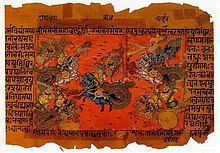
Back দ্বাপর যুগ Bengali/Bangla Dvapara-Yuga German Dvapara Yuga French દ્વાપરયુગ Gujarati द्वापर युग Hindi Dvápara-juga Hungarian Dwaparayuga ID Dvapara Yuga Italian Dwapara Yuga JV ದ್ವಾಪರಯುಗ Kannada

Dvapara Yuga (IAST: Dvāpara-yuga), in Hinduism, is the third and third-best of the four yugas (world ages) in a Yuga Cycle, preceded by Treta Yuga and followed by Kali Yuga.[1][2] Dvapara Yuga lasts for 864,000 years (2,400 divine years).[3][4][5]
According to the Puranas, this yuga ended when Krishna returned to his eternal abode of Vaikuntha.[6] There are only two pillars of religion during the Dvapara Yuga: compassion and truthfulness. Vishnu assumes the colour yellow and the Vedas are categorized into four parts: Rig Veda, Sama Veda, Yajur Veda and Atharva Veda. [citation needed]
- ^ "yuga". Dictionary.com Unabridged (Online). n.d. Retrieved 2021-02-27.
- ^ "dvapara yuga". Dictionary.com Unabridged (Online). n.d. Retrieved 2021-02-27.
- ^ Cite error: The named reference
Godwin 2011was invoked but never defined (see the help page). - ^ Cite error: The named reference
Merriam-Websterwas invoked but never defined (see the help page). - ^ Cite error: The named reference
Springer measurementswas invoked but never defined (see the help page). - ^ Bhāgavata Purāṇa 12.2.29-33